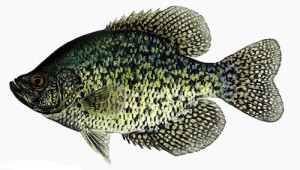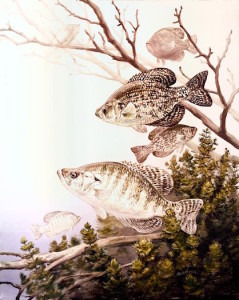Whether you are an avid angler looking for a nice, relaxing day on the water or a novice just learning the sport I have one word for you – CRAPPIE! The crappie is one of the most abundant game fish and is found throughout The United States and Canada. More importantly, they are known for their ability to be easily caught, plus they taste great – both positives for guaranteeing a great day on the water.
 Crappie can be found in most ponds, lakes or slow streams in North America and prefer warm water with a variety of natural or man-made cover. The species is divided into two sub-species, the black crappie (Pomoxisnigromaculatus) and white crappie (Pomoxisannularis).
Crappie can be found in most ponds, lakes or slow streams in North America and prefer warm water with a variety of natural or man-made cover. The species is divided into two sub-species, the black crappie (Pomoxisnigromaculatus) and white crappie (Pomoxisannularis).
Although each species varies slightly in its appearance and distribution, they share many attributes as well and are almost identical regarding how they are caught or processed. Most jurisdictions only differentiate when it comes to recognizing potential record catches, not concerning season, size or creel limits. This means that there is seldom a reason for anglers to strictly identify one from the other, however, should you feel the need just count the dorsal spines – black will have 7-8, the white only 6.
 The first step to catching crappie is locating a potential fishing spot. As I said earlier, crappies are very abundant, and chances are if you have a pond, lake or warm stream near you home that is home to other panfish it also contains crappies. Once you have located potential water, you need to narrow your search to specific hotspots.
The first step to catching crappie is locating a potential fishing spot. As I said earlier, crappies are very abundant, and chances are if you have a pond, lake or warm stream near you home that is home to other panfish it also contains crappies. Once you have located potential water, you need to narrow your search to specific hotspots.
Depending on the season and weather conditions the fish will move from shallow to deeper water, but almost always prefer to be near dense cover. The good news is they tend to travel in large schools – find one and more are likely nearby. They also favor areas containing heavy cover such as downed timber, weed beds and rocky shorelines. Locate these areas and you will further narrow your search.
- Spring: Fish will move towards shallows for spawning, usually protected coves. The majority of fish will be found in near shore cover while larger slabs will tend to hang a bit further from shore especially if there is a large shallow flat or channel edge nearby.
- Summer/ Winter: Crappie will hold close to cover in slightly deeper water, 10-30ft in depth. Again, look for natural structure such as humps, ledges or channels and focus your attention there.
- Fall: This is undoubtedly the hardest time to pin down crappies as they are constantly moving, either chasing the remaining baitfish or outrunning changing weather patterns. Look near shallow brush piles during warmer afternoons and deeper pools when the temperature dips.
Contents
Crappie Tackle
Almost any rod and reel combination will land a crappie and although you could spend $200 on a top of the line crappie rod, a $30 cane pole and worm on a hook may be equally successful. When selecting your set up consider where you will be fishing rather than what you will be targeting.
- Deep Water / Light Cover: Ultralight or lightweight rod & spinning reel combination with 4-10lb. test is an excellent choice, probably the same thing you are using for trout.
- Shallow Water / Heavy Cover: This is when a simple cane pole has the advantage as it lets you simply drop the bait through openings in the cover. Of course, you can accomplish the same thing with a long light to medium rod & bait-caster although I would recommend slightly heavier line ( 6-10lb. test) due to potential snagging issues.
How To Catch Crappie
In my opinion, your choice of terminal tackle (bait or lure selection) is far more important than the rod and reel you have it tied to. Crappies will eat almost anything, but not always at the same time and not in every water. The key is to have a wide variety on hand at all times so you can offer a well-stocked buffet. Luckily crappie lures are relatively small and inexpensive making it easier to acquire and transport a well-stocked tackle box.
Crappie Lures
Jigs: Ensure you have a large selection of jugs, including maribou style, in a variety of sizes and colors. This variety will allow you to match not only what they are interested in eating but also varying water conditions and depths.
Plastic Grubs: Split tail, fantail and curly tailed designs are all popular, the key here is lots of action and small size. Again, have a wide variety of colors both dark and neon on hand.
Spinnerbaits: Small gold or silver willow blade and Colorado spinners work well imitating a wounded minnow, a favorite crappie meal. I would suggest that you save these for use over submerged cover or along the outer edges of thick cover, rather than in the cover itself otherwise you will lose plenty to snags.
Live Bait For Crappie
- Hooks: Crappie love live bait and even if you prefer lures you should have a good supply of No. 1 or size 1/0 – 2/0 hooks available in case you need to dunk a worm or minnow to get the job done.
- Split Shot: If you are resorting to living bait do not forget to have a supply of small split shot on hand to help make your presentation at the correct depth. Adding a bobber or float to your rig can help as well.
Technique
You may need to make several exploratory casts to locate the school, moving from location to location until you do. This is a perfect time to use your spinnerbaits as they are easy to cast and retrieve quickly which allows you to cover a lot of water in a short time. Once you have located the school I suggest you switch to one of the following techniques to better zero in on the best cover, and allow you to detect finer bites. Remember, crappie may nibble rather than strike hard so it is important to feel even the slightest indication of a bite.
- Vertical Jigging: with a jig head tipped with a plastic grub or a bit of bait, dropped into opening in the cover can be deadly against crappies. A slow, slight up and down motion will help to entice hesitant eaters to give your bait a try.
- Suspended Live Bait: Fishing with a live minnow, grub or worm suspended below a small bobber is another excellent tactic. Not only does it present the bait in a more or less natural condition but the bobber assists in detecting those tiny bites crappies are famous for.
- Lures Over Deep Cover: If the school is holding to deeper cover under the waters surface you have a perfect opportunity to toss some ultra-light lures for big fish. Choose spoons, kastmasters or wounded minnows in gold or silver and as small as your rod/reel will reliably cast. Cast past the cover, allow the lure to sink to a depth just above the cover depth, and slowly retrieve over the cover. Adjust your starting point slightly from one cast to the next to cover different sections of the cover.
Regardless of which presentation you opt to try remember that crappies have a delicate, thin tissue mouth and this is how they earned the nickname paper mouth. You do not need an aggressive action to set the hook and too much force is likely to rip the hook loose.
Once you have given crappie fishing a try and figured out the fine details for your water, I have no doubt you will be as hooked as the trophies you fill your bucket with.
